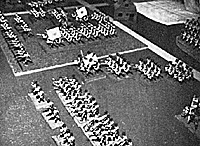 As has already been mentioned, the largest problem facing the examiner of Prussian organization and field strengths is the fact that in 1812, Prussia was not at war. (She did send 6 "combined" infantry regiments and 4 "combined" cavalry regiments with the Grand Army into
Russia. These units were brought up to war strength by combining battalions/squadrons of two different regiments together. Some readers may be familiar with this process in modern context, and appreciate that the units left behind are usually mere "shells.")
As has already been mentioned, the largest problem facing the examiner of Prussian organization and field strengths is the fact that in 1812, Prussia was not at war. (She did send 6 "combined" infantry regiments and 4 "combined" cavalry regiments with the Grand Army into
Russia. These units were brought up to war strength by combining battalions/squadrons of two different regiments together. Some readers may be familiar with this process in modern context, and appreciate that the units left behind are usually mere "shells.")
Not being at war, the Prussian Army was organized on a peace-time T/O, and the size of the army was limited by the Treaty of Paris to 42,000 men. It never did reach that low strength and David Nash's The Prussian Army 1808-15 (TPA) indicates that in March 1812, the Army numbered 65,675. Of these, 20,842 went to Russia with the Grand Army.
Establishment for Grenadier, Musketeer, and Fusilier companies was identical. Musketer, Fusilier and Grenadier battalions had a peace-time establishment of 632 officers and men. Since NAO offers four 8-figure stand Prussian Musketeer and Grenadier Bns., one must assume that they have been organized at 100% of peace-time authorized strengths.
Fusilier Bns., however, are organized under NAO as four 6-figure company stands. It has always been difficult for this writer to understand how this error occurred, and even more difficult to understand why it has been perpetuated through two additional editions.
NAO says: "For this and other reasons, the grenadier and musketeer units in late 1812 were closer to full strength, while the fusilier were less so -- one fusilier battalion muster recorded 400 at one time". An exhaustive study of the references listed in NAO's Prussian Bibliography fails to determine the source for this statement.
In fact, Peter Paret's Yorck and the Era of Prussian Reform (a source quoted by Fred Vietmeyer several times in the pages of The Courier) makes it clear the fusilier establishment was identical to that of musketeers and grenadiers; that the fusiliers were the real "elite" of each regiment, and that great care and time were taken in their training. This writer has not uncovered any source that would indicate that fusiliers were maintained at lower strengths in such a substantial number of the total tens as to justify organizing them some 160 men less than a musketeer or grenadier Bn. Prussian Fusilier Bns. on the wargame table at 1:20 should be represented by four 8-figure split company stands (at peace-time strength).
Peace-time authorized strength for Line Jager and Schutzen Bns. (there was one of each), according to TPA, was 429. NAO provides for a wargame Bn. of four 6-figure split company stands, which is probably close enough.
All Prussian cavalry regiments are organized under NAO with four 6-figure squadrons (and a 3-figure command stand), which clearly reflects, again, 100% of peace-time authorized strengths.
But all of this begs the basic problem. By organizing Prussian infantry at 100% (or more) of peace-time establishment, has NAO accurately reflected "the actual number of men per unit in the field" (emphasis added), as it set itself out to do? TPA, page 15 says: " -- but the war establishment was larger in that each company added some 50 privates to its ranks upon mobilization.
Thus, the full strength of a battalion during the 1813-1815 period was either some 630 [Schutzen & Jager] or 830 men. In 1813, some units tended to exceed this authorized establishment and, without exception, this was done by Jager and Schutzen units, who were deployed as half battalions, each fielding some 400 men.... As a generalization, however, the establishments were fairly well maintained and the average strength of a battalion on active service was somewhere between 750 and 850 men, NCO's and officers." (Emphasis added.)
It seems clear that NAO has missed its mark here. But the problem is all wrapped up in deciding how to depict the average field strength of a regiment of a country, which was "in the field" in 1812. More on that later.
More CLS
Back to Table of Contents -- Courier Vol. 1 #2
To Courier List of Issues
To MagWeb Master Magazine List
© Copyright 1979 by The Courier Publishing Company.
This article appears in MagWeb (Magazine Web) on the Internet World Wide Web.
Other military history articles and gaming articles are available at http://www.magweb.com